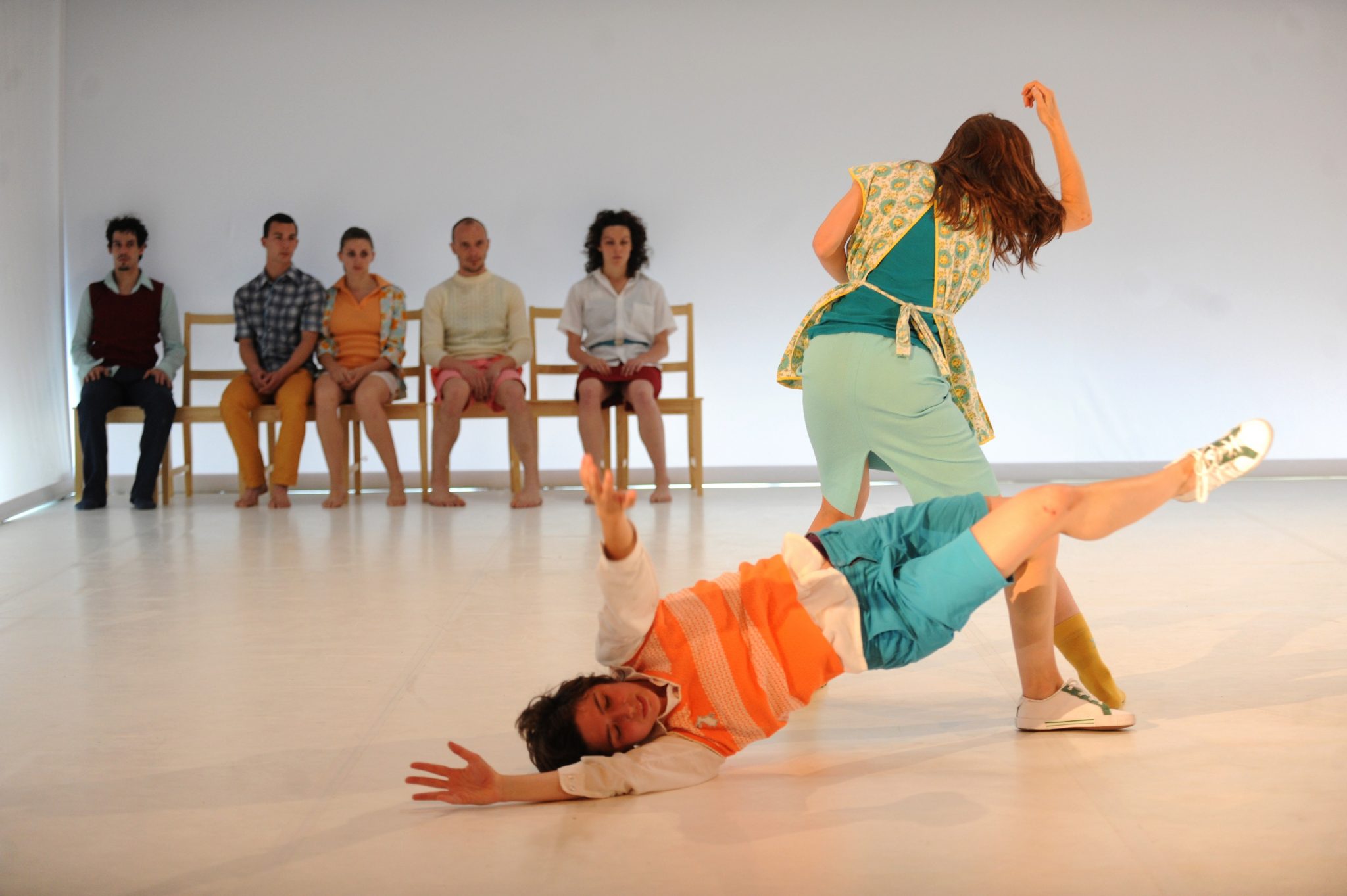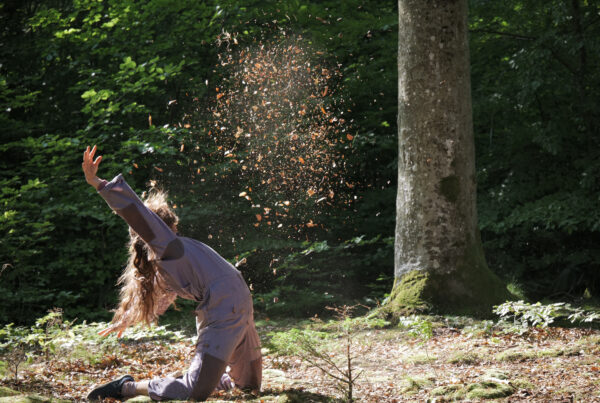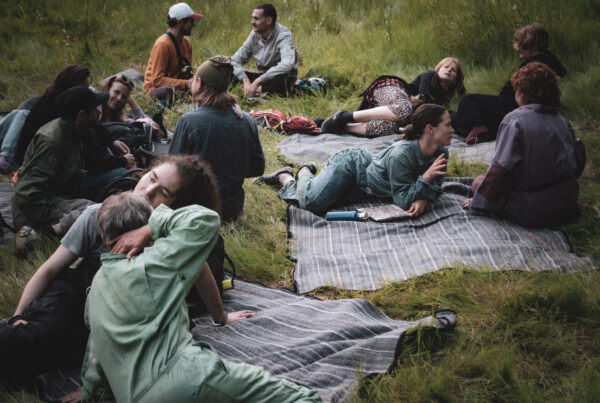Source: Quodlibetica 10 – Cartographies
Author: Lightsey Darst
Date: 10.1.10
Poet and dance reviewer Lightsey Darst writes about BodyCartography in Quodlibetica.
“Let’s look at a dance.
Let’s look at you looking at a dance.
Let’s look at you dancing.
When we look at you, you are dancing. How does it feel?…”
Here’s a dance to look at. It’s by Olive Bieringa and Otto Ramstad, otherwise known as The BodyCartography Project. It’s an excerpt from Mammal, a recent commission for the Lyon Opera Ballet. Set aside the you-had-to-be-there that is a constant with recordings of live dance, and what do you see?
Mammal, a commission for the Lyon Opera Ballet from BodyCartography Project on Vimeo.
A lot of brightly-dressed young people, bounding or twitching around in a bright white space. The word “spastic” might come to mind (derivation: from span). Connection, disconnection. What am I supposed to see, you might wonder.
Olive Bieringa and Otto Ramstad met in 1999 at a disability movement research retreat called Diverse Dance. They were drawn there by currents that run through the contact improvisation community—contact being a dance form invented by Steve Paxton and others in the 70s that explores (in the simplest form) points of contact, and thus (by extension) weight-sharing, sensation, impulses, empathy, safety, risk, etc.—the inside and outside of human physics, more or less. (Steve Paxton: “When an apple fell on his head, Newton was inspired to describe the three laws of motion that carry his name. . . In his attempt to be objective, Newton overlooked the question of how it feels to be the apple.”)
Bieringa had already founded The BodyCartography Project (henceforth, BC) in 1997, the name reflecting an overlay of interests. “I was interested in how we learn all these different maps,” she says—maps for the body, ways to build an inner awareness and an outer carriage of the body, maps that come from various dance or body trainings as well as cultural maps. “And then I was interested in flipping it,” she adds, and looking at how the body is mapped in various spaces, how architecture constrains or frees the body.
Ramstad was more than ready to add to BC’s emerging concerns. Growing up in Minneapolis, he’d taken years of dance/movement from Suzanne River, the local doyenne of Body-Mind Centering (a system of somatic training, i.e., a method for understanding and experiencing the body more fully). Like Bieringa, he’d already spent years soaking up the concepts and sensations of the contact/contemporary dance/somatics world.
Bieringa and Ramstad—how can I put this? For a lot of us, arriving at the structuralist and deconstructionist thought that animates so much contemporary art has been a struggle in itself. Even if we’d rather not talk about it, many of us recall meaning, certainty, morality, or mysticism with loving nostalgia. (We are at the Tower, to put it Tarotly.) I constantly feel like a bad child in the contemporary art world; my reactions, whether positive or negative, vibrate with rebellion, mischief, obstinacy, unappeasable desire. (Which I don’t at all mind; I find plenty of friends for my state of mind, from the naughty Smorkin Labbits to the gross-out Gurlesque to longing believers like Hanna Liden.)
But Bieringa and Ramstad—well, they seem to have started, without demolition, right at the top, starting asking the questions others strive to understand. Bieringa: “I took a ballet class when I was a kid and I hated it, it was so bourgeois.” Ramstad: “I don’t remember anything” of his dance training; “I think I did it in a totally unconscious way.” Bieringa moves fearlessly, not afraid of scars or dirt, to say nothing of dirty looks. Ramstad goes in all directions, as if every possibility were open at all times (which it is, only most of us don’t live that nakedly). The word amphibious comes to mind. Altogether, Bieringa and Ramstad strike me as New People, unhindered by love of indefensible or inexplicable traditions.
Back to that dance. Instead of looking, try feeling, along the lines of these instructions Bieringa gave me: “Play with changing the tone of your muscles as a way to generate movement.” What happens?
I recommend trying this not with your whole body (at first), but with your hands and arms. They’re easier, and you can sit still (relatively) and watch them. Probably at this moment you are thinking “Right, right, play with my hands, I’ll pencil that in,” but no, I want you to really try this. Now. Pick up one hand and move it naturally, unnaturally, tense it, release it. Play with speed, direction, coordination. Make your two hands do different things. Recognize just how much movement your hands are capable of. Explore the possible.
What happens—and I’d like to put this upside-down and backwards at the bottom of the page, like a puzzle answer, because I’m afraid you’ll skip the exercise and go straight to the explanation—what happens is that time and space disappear. That is, time in the linear, measured sense goes away, space in the usual allowed-paths sense opens out, and you get time-space as dimensions, as a playing field. It’s precious—there will never be enough time or space to explore even the motion of your two hands—yet vast: time-space extends all around you, awaiting your choices.
Choice is precisely the point here. Ramstad describes the hand exercise: “You just start feeling your hands.” Is it paralyzing? “It is a little bit. But then you just want to move.” Not only do you want to, you have to: “Once you are aware of something you have to choose what to do with it as opposed to it being unconscious. Our culture is so mental—most people are not that aware of the shapes they are making.” And if we become aware, it’s usually in an unpleasant way—someone makes fun, we trip, we’re told not to slouch. But here, there are no rules.
More instructions from Bieringa: “Next time you are in a group context, notice what is inside and what is outside. Who is an ‘insider’ and who is an ‘outsider’? Are you drawn towards or away from them?”
Try this as you go through downtown, and you’ll see that insiders and outsiders are distinguished by clothes, yes, but more than that, by how they hold themselves. “Not normal” sticks out to us with a limp or a loose stride or a crooked neck, and the instinctive reaction is avoidance: don’t talk, don’t even look, because “identification with someone who is acting in a non-average manner implicates you,” as Ramstad observes. “As little as just watching a homeless person connects you to them, and so then when people look at the homeless person, and they see you looking at them, then they’re looking at you too”—and no one wants that.
We’re crossing now into the territory of the other half of BC’s work, going from the training, the culture-determined map the individual carries within the body, to the map the man-made world impresses on the body from outside. So let’s look at another dance.
Nicollet Avenue from BodyCartography Project on Vimeo.
Custom, security, and commerce restrict movement in public. For BC, this is a creative problem: “How can we reclaim some of these public spaces as places that we could be fully embodied and fully physical?” asks Bieringa. Go stands in here for an entire body of work, of site-specific improvs in public spaces from Brooklyn to Paris to Zurich to BC’s home base, Minneapolis.
I asked what kinds of contexts work best for this sort of exploration. Airports were a favorite before increased security made them impossible. Malls, however, don’t work—in part because they’re too controlled, and in part because “the problem with being in a mall context is that everything you do, unless it’s really radically extreme, just becomes totally commodified right away,” says Ramstad. “Everyone just assumes this is some sort of scheme or sales thing.” For similar reasons, Minneapolis’s Nicollet Mall proper does not interest them, but the southern end of Nicollet Mall, the transitional end, does. Bieringa enjoys leading an audience “from this white collar Target-land up to this other zone, through abandoned land and different things on the way—-all the different restaurants, the hip-hop barber, the Somali café.”
Watch Go (whichever version) and you’ll soon find you’re only half watching the performer. The architecture, the passersby, the camera’s journey, your own imagined journeys through the space, all animate these seeming “nowheres.” Like graffiti, the performer casts light on and humanizes the inconsiderate space.
But as boundary spaces are closed up, it’s harder to find areas for productive intervention, particularly in Minneapolis, where “everything is cemented over and nicely controlled, so there’s no weeds anywhere,” and the only liminal space left is a frozen lake, where no one cares what you do, and thus what you do doesn’t matter.
The difficulty of using public space in Minneapolis (aside from the evil winter) has turned BC towards a wider interpretation of site-specific, with site becoming macro- or meta-site. In Minneapolis, BC has shifted towards “crafting a performance work rather than just doing research or having an ecstatic self-process,” Bieringa says.
All the ideas of their previous work persist in their stage work, though. Ramstad and Bieringa told me of the feedback they received from three-year Ae Wilder on their 2007 site-specific work Holiday House. “Some things that are supposed to be inside are outside, and some things that are supposed to be outside are inside,” Wilder said. “Well, Ae, is that confusing, or exciting?” Bieringa asked. “It’s confusing and exciting,” she said.
This language—inside/outside, confusing and exciting—has become a favorite way for them to aim and describe their work. Bieringa recalls that after being immersed in dance training, she became curious about “how to also be in the world. All these dance practices or embodied practices were happening inside the studio, or inside a black box theater. What would happen if we took the tuning score out onto the streets, or if we had a contact jam in business suits right in the middle of the financial district?” The strangely cut-off culture of much of the dance world bothers them. “People a lot of times want to show dance, but not people,” Ramstad says; so much dance goes to pains, in fact, to conceal the personhood of the dancers, their inner reality and their outside-the-theater reality. “There are so many things,” Bieringa says, “that are taken for granted, that are not considered.” Opening the unconsidered routes is BC’s mission.
Now let’s return to that dance and look again. Watch how flickers in tone create motion, how choices open up like abysses in the normalcy suggested by the clothing, the chairs, the bright light. Notice where normal and not-normal diverge and how you feel when they do. Notice how space-time flows around normal and not-normal, how your attention flows.
Probably, even without reading this far, you knew not to look for story, because this is an abstract dance, or so we call it. But if you think about it, what’s more abstract: contemporary French dancers pretending to be fairies and princesses, or contemporary French dancers being themselves? Perhaps we should call this dance concrete instead. No, there’s no one story. . . but there are the constantly shifting stories of these real people, and there are the hundred stories your mind involuntarily makes out of the brief relations on stage. Watch those, enjoy those.
Boy, looking like this is exhausting, huh? It’s like trying to wiggle your little toes. Go on, take your socks off and try it: look at that left little toe and will it to move. Where is that nerve, what is that pathway? You know it’s in you, but you haven’t traced it in a long time, maybe not since you were a kid . . .
. . . which is not the Point (there is no Point), but let’s say the wavelength that you need here. Childhood as content gets gooily nostalgic or dark quick, but childhood as mode is something different, rare, and precious . . .
. . . though we might not immediately recognize it as such because the confusion comes uppermost in the patterned, sense-making, law-abiding, adult body-mind. The confusion comes first and masks the excitement.
Postmodern dance has always suffered from a strange contradiction. In being willfully less abstract, less virtuosic, closer to real life, postmodern dancemakers reached out to a broader audience—but the broad audience never materialized. Instead, the public overall still believes that dance is virtuosic movement, is beautiful bodies revealed in beautiful costumes, is not me, not real world, is up there on stage. Dance is the trick montages of So You Think You Can Dance.
“There’s a gap of understanding,” Bieringa says. “Though I have to say, from performing on the streets for so many years, people do get it. When you actually make time to stop and talk with people about what they’re seeing, and they get over their first reactionary response, that this is some kids on drugs, or it’s dance and I don’t understand dance because I’ve never seen any dance in my entire life, and then you ask them what they’re really seeing, they’re full of stories about meaning”—about the meanings they made, the whirl of the minds as they watched—a whirl that matches the sensory whirl of the performers as they navigate the suddenly multifold world. This mutual whirlwind is a dance. “It’s just how do you create the invitation for that? How do you invite them to value that experience? And how do you create experiences for people that are complicated, and not reductive, and really invite people to engage with them? That’s what I’m interested in.”



